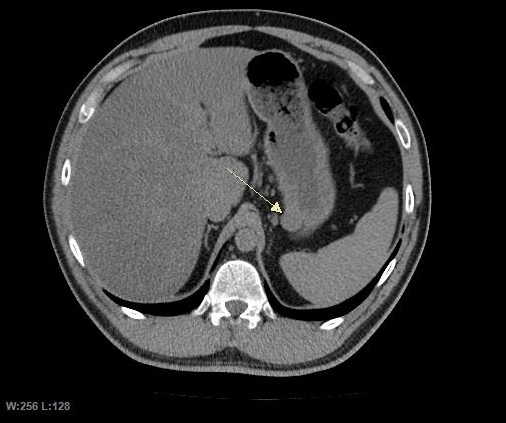Gastrointestinal stromal tumor CT: Difference between revisions
Akshun Kalia (talk | contribs) |
Akshun Kalia (talk | contribs) |
||
| Line 33: | Line 33: | ||
*evaluation of surrounding mesentery | *evaluation of surrounding mesentery | ||
MRI is more accurate than CT for delineating rectal GISTs and in detecting liver metastasis, hemorrhage and necrosis. | MRI is more accurate than CT for delineating rectal GISTs and in detecting liver metastasis, hemorrhage and necrosis. | ||
[[image:GIST CT-Noncontrast image.jpg|thumb|center|CT without contrast showing an incidental finding of a small GIST in the posterior stomach wall (arrow). ([Courtesy: By Inversitus - Own work, CC BY-SA 3.0, https://commons.wikimedia.org/w/index.php?curid=33932071])]] | |||
==References== | ==References== | ||
Revision as of 23:11, 17 December 2017
Editor-In-Chief: C. Michael Gibson, M.S., M.D. [1]Associate Editor(s)-in-Chief: Parminder Dhingra, M.D. [2]
|
Gastrointestinal stromal tumor Microchapters |
|
Differentiating Gastrointestinal stromal tumor from other Diseases |
|---|
|
Diagnosis |
|
Treatment |
|
Case Studies |
|
Gastrointestinal stromal tumor CT On the Web |
|
American Roentgen Ray Society Images of Gastrointestinal stromal tumor CT |
|
Directions to Hospitals Treating Gastrointestinal stromal tumor |
|
Risk calculators and risk factors for Gastrointestinal stromal tumor CT |
Overview
Abdominal CT scan may be helpful in the diagnosis of gastrointestinal stromal tumor.
CT scan
Appearance of GIST on a CT scan vary with size and location. Typically the mass is of soft tissue density with central areas of lower density when necrosis is present (usually in larger tumours). Enhancement is typically peripheral (due to central necrosis). Calcification is uncommon (3%). Metastases (distant, peritoneal, omental) or direct invasion into adjacent organs may be seen in more aggressive lesions. Lymph node enlargement is not a feature.[1][2][3]
- A CT scan of the abdomen and pelvis is the imaging test of choice and an important tool in the diagnosis of GIST.
- CT scan can be used to determine the size, location and staging of the GIST.
- A CT can accurately de-mark surrounding structures, multiple tumors and metastases.
- The size of GIST determined by a CT scan can also be ised to classify the severity of GIST.
- Small GIST (< 5 cm) are homogeneous with clear boundaries and intraluminal pattern of growth.
- Intermediate GIST (size of 5-10 cm) are heterogeneous with irregular borders and intra or extra-luminal pattern of growth.
- Large GISTs (>10 cm) are heterogeneous with irregular borders and local or distant spread.
- Malignant GIST with metastasis may have the following findings:
- Size greater than 10 cm
- Calcifications
- Irregular margins
- Heterogeneous, lobulated
- Lymphadenopathy
- Ulceration
- Extraluminal and mesenteric fat infiltration
CT with contrast (oral) is superior to normal CT. CT with contrast can better visualize the
- thickness of the small bowel
- deep ileal loops without superimposition
- evaluation of surrounding mesentery
MRI is more accurate than CT for delineating rectal GISTs and in detecting liver metastasis, hemorrhage and necrosis.

References
- ↑ "Gastrointestinal stromal tumour".
- ↑ Tran T, Davila JA, El-Serag HB (2005). "The epidemiology of malignant gastrointestinal stromal tumors: an analysis of 1,458 cases from 1992 to 2000". Am. J. Gastroenterol. 100 (1): 162–8. doi:10.1111/j.1572-0241.2005.40709.x. PMID 15654796.
- ↑ Miettinen M, Makhlouf H, Sobin LH, Lasota J (2006). "Gastrointestinal stromal tumors of the jejunum and ileum: a clinicopathologic, immunohistochemical, and molecular genetic study of 906 cases before imatinib with long-term follow-up". Am. J. Surg. Pathol. 30 (4): 477–89. PMID 16625094.